The Windows Help and Support is a misleading ‘ad’ web page that made in order to trick you into calling fake Microsoft Windows Help Support service. If the “Windows Help and Support” alerts keeps popping up in your browser then this might be a sign that your computer is infected with an adware (also known as ‘ad-supported’ software). It is a type of malicious programs that designed to open tons of intrusive advertisements. Unlike viruses, the adware will not delete or infect your files, but its actions will cause some problems with your internet browser. This is because, it will hijack your computer, get full access to your internet browsers such as Mozilla Firefox, Chrome, Internet Explorer and Edge and has the ability to modify their settings. Of course, it did not ask you for permission and do it secretly as possible. Once your internet browser settings will be modified, you’ll be re-directed to unwanted advertisements, some of which can lead to harmful or misleading pages like these Windows Help and Support pop up alerts. For this reason, we recommend that you start the clean up of your PC system sooner and thereby get rid of “Windows Help and Support” popup scam from your browser.
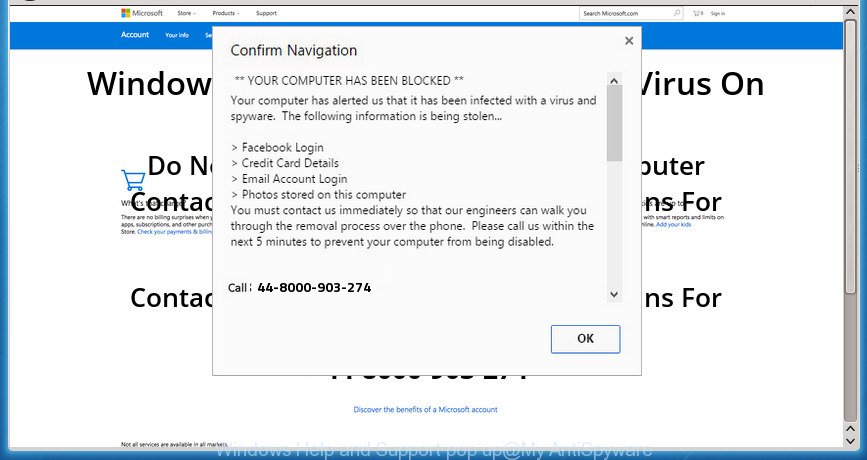
Windows Help and Support popup alerts are misleading advertising
The ad supported software which displays misleading Windows Help and Support pop-up scam on your computer, may insert tons of ads directly to the web sites that you visit, creating a sense that the ads have been added by the authors of the web site. Moreover, a legal advertising links may be replaced on the fake advertisements, that will offer to download and install various unnecessary and malicious applications. The worst is, the adware has the ability to collect your personal info (your ip address, what is a site you are viewing now, what you are looking for on the Net, which links you are clicking), which can later transfer to third parties.
The adware usually infects only the Google Chrome, Firefox, Edge and IE by modifying the internet browser’s settings or installing a malicious add-ons. Moreover, possible situations, when any other web browsers will be hijacked too. The ‘ad supported’ software will perform a scan of the PC for internet browser shortcuts and change them without your permission. When it infects the internet browser shortcuts, it will add the argument like ‘http://site.address’ into Target property. So, each time you start the web-browser, you will see an undesired “Windows Help and Support” web page.
Instructions which is shown below, will help you to clean your PC system from the adware as well as delete “Windows Help and Support” undesired pop up ads from the Google Chrome, Internet Explorer, Firefox and Edge and other browsers.
How to remove Windows Help and Support pop up
Fortunately, we’ve an effective way which will assist you manually or/and automatically remove “Windows Help and Support” from your browser and bring your internet browser settings, including start page, newtab page and search engine by default, back to normal. Below you will find a removal guide with all the steps you may need to successfully remove adware and its traces. Read it once, after doing so, please print this page as you may need to close your browser or reboot your computer.
To remove Windows Help and Support pop-up, perform the following steps:
- Remove Windows Help and Support pop-up without any utilities
- Remove suspicious applications through the Control Panel of your PC
- Remove “Windows Help and Support” pop-up from Chrome
- Get rid of “Windows Help and Support” pop-up from Internet Explorer
- Remove “Windows Help and Support” from FF by resetting web browser settings
- Remove unwanted Scheduled Tasks
- Clean up the browsers shortcuts which have been hijacked by ad-supported software
- Windows Help and Support pop up automatic removal
- Use AdBlocker to block “Windows Help and Support” and stay safe online
- Method of “Windows Help and Support” pop up intrusion into your system
- To sum up
Remove Windows Help and Support pop-up without any utilities
The instructions will help you remove “Windows Help and Support” popup. These “Windows Help and Support” removal steps work for the Google Chrome, Internet Explorer, Firefox and Edge, as well as every version of Windows operating system.
Remove suspicious applications through the Control Panel of your PC
First, you should try to identify and delete the program that causes the appearance of intrusive ads or web-browser redirect, using the ‘Uninstall a program’ which is located in the ‘Control panel’.
Windows 8, 8.1, 10
First, click Windows button

Once the ‘Control Panel’ opens, click the ‘Uninstall a program’ link under Programs category as shown on the screen below.

You will see the ‘Uninstall a program’ panel as displayed on the image below.

Very carefully look around the entire list of programs installed on your personal computer. Most likely, one or more of them are responsible for the appearance of advertisements and browser redirect to the unwanted “Windows Help and Support” web site. If you have many programs installed, you can help simplify the search of harmful applications by sort the list by date of installation. Once you have found a suspicious, unwanted or unused application, right click to it, after that press ‘Uninstall’.
Windows XP, Vista, 7
First, click ‘Start’ button and select ‘Control Panel’ at right panel as displayed below.

After the Windows ‘Control Panel’ opens, you need to press ‘Uninstall a program’ under ‘Programs’ as displayed on the image below.

You will see a list of software installed on your personal computer. We recommend to sort the list by date of installation to quickly find the applications that were installed last. Most likely they responsibility for the appearance of pop-up advertisements and web-browser redirect. If you are in doubt, you can always check the application by doing a search for her name in Google, Yahoo or Bing. After the program which you need to delete is found, simply click on its name, and then press ‘Uninstall’ as shown below.

Remove “Windows Help and Support” pop-up from Chrome
Run the Reset browser tool of the Chrome to reset all its settings like homepage, newtab and search provider by default to original defaults. This is a very useful tool to use, in the case of web-browser redirects to unwanted ad pages such as “Windows Help and Support”.

- First launch the Google Chrome and click Menu button (small button in the form of three dots).
- It will show the Google Chrome main menu. Choose More Tools, then click Extensions.
- You will see the list of installed extensions. If the list has the extension labeled with “Installed by enterprise policy” or “Installed by your administrator”, then complete the following tutorial: Remove Chrome extensions installed by enterprise policy.
- Now open the Chrome menu once again, press the “Settings” menu.
- You will see the Chrome’s settings page. Scroll down and click “Advanced” link.
- Scroll down again and click the “Reset” button.
- The Google Chrome will display the reset profile settings page as on the image above.
- Next click the “Reset” button.
- Once this process is done, your web browser’s new tab, startpage and search engine by default will be restored to their original defaults.
- To learn more, read the blog post How to reset Google Chrome settings to default.
Get rid of “Windows Help and Support” pop-up from Internet Explorer
In order to restore all internet browser start page, newtab and search engine by default you need to reset the Microsoft Internet Explorer to the state, which was when the Windows was installed on your system.
First, open the Internet Explorer, press ![]() ) button. Next, press “Internet Options” as shown in the following example.
) button. Next, press “Internet Options” as shown in the following example.

In the “Internet Options” screen select the Advanced tab. Next, click Reset button. The IE will show the Reset Internet Explorer settings dialog box. Select the “Delete personal settings” check box and click Reset button.

You will now need to restart your personal computer for the changes to take effect. It will get rid of adware which cause misleading “Windows Help and Support” pop up to appear, disable malicious and ad-supported web-browser’s extensions and restore the Microsoft Internet Explorer’s settings like startpage, newtab page and default search provider to default state.
Remove “Windows Help and Support” from FF by resetting web browser settings
If your Firefox web-browser is re-directed to “Windows Help and Support” without your permission or an unknown search provider opens results for your search, then it may be time to perform the web browser reset.
First, launch the Mozilla Firefox and click ![]() button. It will display the drop-down menu on the right-part of the internet browser. Further, press the Help button (
button. It will display the drop-down menu on the right-part of the internet browser. Further, press the Help button (![]() ) as shown on the screen below
) as shown on the screen below
.

In the Help menu, select the “Troubleshooting Information” option. Another way to open the “Troubleshooting Information” screen – type “about:support” in the browser adress bar and press Enter. It will display the “Troubleshooting Information” page as shown below. In the upper-right corner of this screen, press the “Refresh Firefox” button.

It will open the confirmation dialog box. Further, click the “Refresh Firefox” button. The Firefox will begin a procedure to fix your problems that caused by the adware which causes misleading “Windows Help and Support” popup on your browser. Once, it is done, press the “Finish” button.
Remove unwanted Scheduled Tasks
If the intrusive “Windows Help and Support” web page opens automatically on Windows startup or at equal time intervals, then you need to check the Task Scheduler Library and get rid of all the tasks that have been created by adware.
Press Windows and R keys on the keyboard at the same time. This shows a prompt that titled as Run. In the text field, type “taskschd.msc” (without the quotes) and click OK. Task Scheduler window opens. In the left-hand side, press “Task Scheduler Library”, as on the image below.
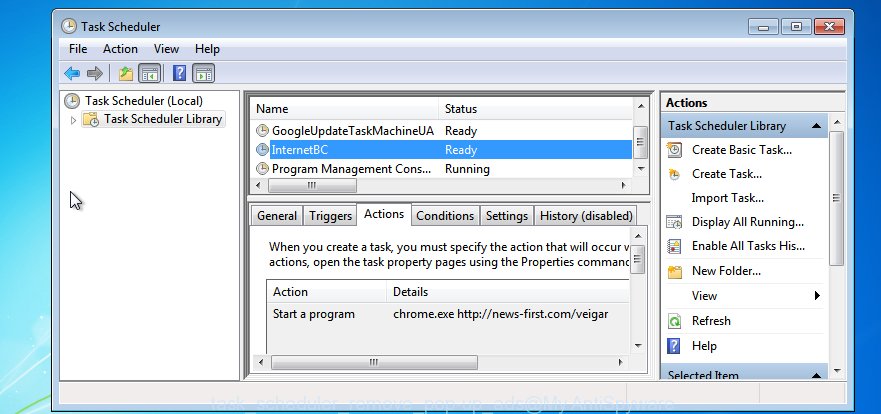
Task scheduler
In the middle part you will see a list of installed tasks. Please select the first task, its properties will be open just below automatically. Next, click the Actions tab. Pay attention to that it launches on your PC. Found something like “explorer.exe http://site.address” or “chrome.exe http://site.address”, then remove this harmful task. If you are not sure that executes the task, check it through a search engine. If it’s a component of the malicious program, then this task also should be removed.
Having defined the task that you want to remove, then press on it with the right mouse button and choose Delete as displayed on the image below.

Delete a task
Repeat this step, if you have found a few tasks which have been created by malicious application. Once is finished, close the Task Scheduler window.
Clean up the browsers shortcuts which have been hijacked by ad-supported software
Important to know, most anti malware software which are able to remove adware that shows misleading “Windows Help and Support” popup scam on your computer, but unable to search for and recover changed shortcut files. So, you need to fix the desktop shortcut files for your Google Chrome, IE, Firefox and Microsoft Edge internet browsers manually.
Click the right mouse button to a desktop shortcut file which you use to launch your web browser. Next, select the “Properties” option. Important: necessary to click on the desktop shortcut for the internet browser which is rerouted to the “Windows Help and Support” or other undesired web-site.
Further, necessary to look at the text that is written in the “Target” field. The adware which made to show misleading “Windows Help and Support” pop-up scam within your internet browser can change the contents of this field, which describes the file to be start when you open your web-browser. Depending on the browser you’re using, there should be:
- Google Chrome: chrome.exe
- Opera: opera.exe
- Firefox: firefox.exe
- Internet Explorer: iexplore.exe
If you’re seeing an unknown text similar to “http://site.addres” which has been added here, then you should remove it, as on the image below.

Next, click the “OK” button to save the changes. Now, when you launch the browser from this desktop shortcut file, it does not occur automatically redirect on the “Windows Help and Support” web-page or any other annoying pages. Once the step is complete, we recommend to go to the next step.
Windows Help and Support pop up automatic removal
Many antivirus companies have created applications that help detect ad supported software and thereby get rid of “Windows Help and Support” from the Mozilla Firefox, Chrome, Internet Explorer and MS Edge internet browsers. Below is a a few of the free programs you may want to use. Your computer may have tons of PUPs, ad supported software and hijackers installed at the same time, so we recommend, if any unwanted or harmful program returns after rebooting the computer, then start your personal computer into Safe Mode and run the anti-malware tool again.
How to remove “Windows Help and Support” pop up with Zemana Anti-malware
We recommend using the Zemana Anti-malware. You can download and install Zemana Anti-malware to scan for and get rid of “Windows Help and Support” pop-up scam from the Google Chrome, Firefox, Microsoft Edge and Microsoft Internet Explorer web-browsers. When installed and updated, the malware remover will automatically check and detect all threats exist on your system.

- Visit the page linked below to download Zemana AntiMalware (ZAM). Save it on your MS Windows desktop or in any other place.
Zemana AntiMalware
164806 downloads
Author: Zemana Ltd
Category: Security tools
Update: July 16, 2019
- When downloading is complete, close all software and windows on your computer. Open a directory in which you saved it. Double-click on the icon that’s named Zemana.AntiMalware.Setup.
- Further, press Next button and follow the prompts.
- Once install is complete, click the “Scan” button . Zemana Anti Malware (ZAM) utility will begin scanning the whole machine to find out adware which displays misleading “Windows Help and Support” pop-up on your personal computer. Depending on your computer, the scan may take anywhere from a few minutes to close to an hour. While the Zemana Anti-Malware (ZAM) tool is checking, you can see number of objects it has identified as being infected by malware.
- After the scan get finished, Zemana will show a list of all items detected by the scan. Review the report and then click “Next”. After the cleaning procedure is finished, you can be prompted to reboot your PC system.
Run Malwarebytes to delete “Windows Help and Support” pop-up
We recommend using the Malwarebytes Free that are completely clean your machine of the ad-supported software. The free utility is an advanced malware removal program designed by (c) Malwarebytes lab. This program uses the world’s most popular anti-malware technology. It is able to help you delete undesired “Windows Help and Support” pop-up scam from your web browsers, PUPs, malware, browser hijackers, toolbars, ransomware and other security threats from your personal computer for free.
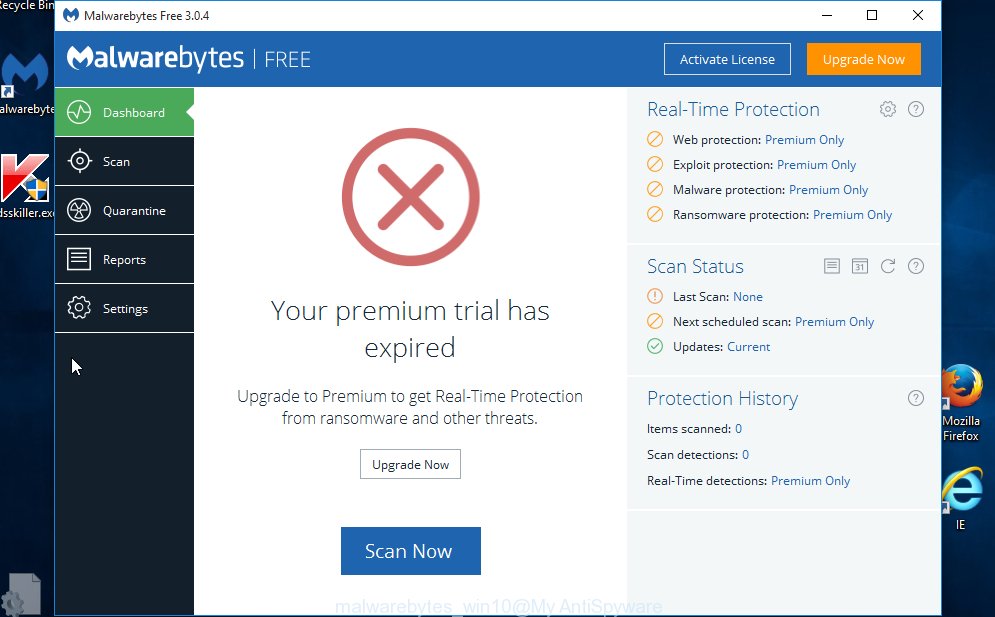
- Download MalwareBytes Anti-Malware on your machine from the following link.
Malwarebytes Anti-malware
327057 downloads
Author: Malwarebytes
Category: Security tools
Update: April 15, 2020
- Once downloading is complete, close all applications and windows on your PC. Open a file location. Double-click on the icon that’s named mb3-setup.
- Further, press Next button and follow the prompts.
- Once installation is done, press the “Scan Now” button . MalwareBytes Anti Malware (MBAM) tool will start scanning the whole machine to find out ad-supported software which designed to display misleading “Windows Help and Support” popup within your browser. A scan may take anywhere from 10 to 30 minutes, depending on the number of files on your system and the speed of your computer. While the MalwareBytes AntiMalware tool is checking, you can see how many objects it has identified as being infected by malicious software.
- As the scanning ends, MalwareBytes Free will show a list of found threats. Review the scan results and then press “Quarantine Selected”. After that process is finished, you may be prompted to restart your personal computer.
The following video offers a steps on how to delete browser hijackers, adware and other malicious software with MalwareBytes Anti-Malware (MBAM).
Use AdwCleaner to remove “Windows Help and Support” pop up scam from browser
AdwCleaner is a free removal utility that can scan your machine for a wide range of security threats like malware, adwares, PUPs as well as ad supported software that causes multiple misleading “Windows Help and Support” alerts and pop ups. It will perform a deep scan of your machine including hard drives and MS Windows registry. Once a malicious software is found, it will allow you to delete all detected threats from your PC by a simple click.
Please go to the following link to download the latest version of AdwCleaner for MS Windows. Save it on your MS Windows desktop.
225541 downloads
Version: 8.4.1
Author: Xplode, MalwareBytes
Category: Security tools
Update: October 5, 2024
After the downloading process is complete, open the folder in which you saved it and double-click the AdwCleaner icon. It will start the AdwCleaner tool and you will see a screen as displayed below. If the User Account Control dialog box will ask you want to launch the program, click Yes button to continue.
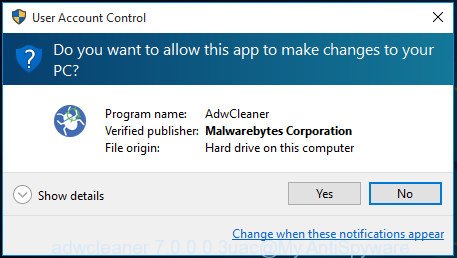
Next, press “Scan” to begin checking your computer for the ad-supported software that causes internet browsers to display misleading “Windows Help and Support” pop-up. This procedure can take quite a while, so please be patient. During the scan AdwCleaner will detect all threats exist on your system.
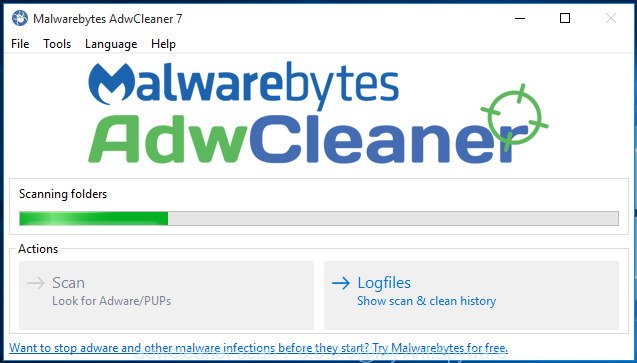
When the scanning is finished, AdwCleaner will open a scan report as displayed below.
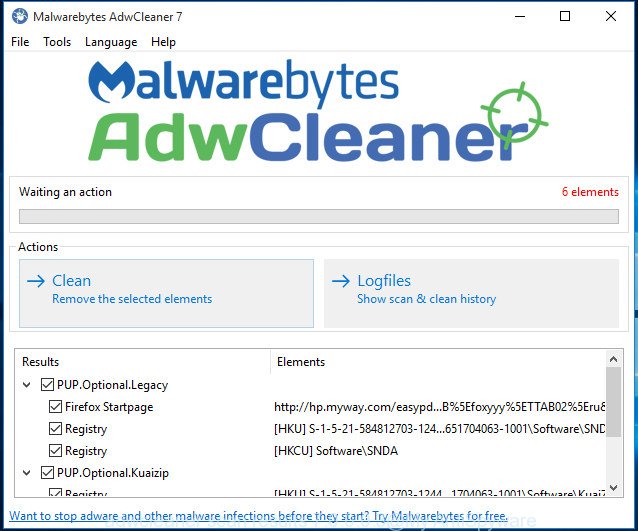
Review the results once the tool has finished the system scan. If you think an entry should not be quarantined, then uncheck it. Otherwise, simply press “Clean” button. It will show a dialog box. Click “OK” button. The AdwCleaner will begin to delete ad supported software that causes browsers to show misleading “Windows Help and Support” popup. Once finished, the utility may ask you to restart your PC system. After reboot, the AdwCleaner will open the log file.
All the above steps are shown in detail in the following video instructions.
Use AdBlocker to block “Windows Help and Support” pop-up and stay safe online
Use ad-blocking program like AdGuard in order to stop advertisements, malvertisements, pop-ups and online trackers, avoid having to install malicious and adware browser plug-ins and add-ons which affect your computer performance and impact your computer security. Surf the Internet anonymously and stay safe online!
Installing the AdGuard adblocker program is simple. First you will need to download AdGuard from the following link. Save it on your Microsoft Windows desktop.
26841 downloads
Version: 6.4
Author: © Adguard
Category: Security tools
Update: November 15, 2018
When the downloading process is complete, double-click the downloaded file to start it. The “Setup Wizard” window will show up on the computer screen as displayed in the following example.

Follow the prompts. AdGuard will then be installed and an icon will be placed on your desktop. A window will show up asking you to confirm that you want to see a quick tutorial as shown in the figure below.

Press “Skip” button to close the window and use the default settings, or click “Get Started” to see an quick tutorial which will help you get to know AdGuard better.
Each time, when you launch your computer, AdGuard will start automatically and block popup advertisements, “Windows Help and Support” pop-up alerts, as well as other malicious or misleading web-pages. For an overview of all the features of the application, or to change its settings you can simply double-click on the AdGuard icon, which may be found on your desktop.
Method of “Windows Help and Support” pop up intrusion into your system
The ad-supported software come as a part of various free programs, as a supplement, which is installed automatically. This is certainly not an honest way to get installed onto your PC system. To avoid infecting of your computer and side effects in the form of intrusive “Windows Help and Support” pop-up advertisements, you should always carefully read the Terms of Use and the Software license. Additionally, always select Manual, Custom or Advanced installation method. This allows you to disable the install of unnecessary and often harmful programs. Even if you uninstall the freeware from your system, this ad-supported software will not be fully removed. This means that you should manually remove ad-supported software that developed to display misleading “Windows Help and Support” pop up scam within your web browser by follow the step by step guide above.
To sum up
After completing the steps outlined above, your PC should be free from ad-supported software that displays misleading “Windows Help and Support” popup on your machine and other malicious software. The Chrome, IE, Firefox and Edge will no longer reroute you to various unwanted web-sites like “Windows Help and Support”. Unfortunately, if the guide does not help you, then you have caught a new ad supported software, and then the best way – ask for help in our Spyware/Malware removal forum.




















